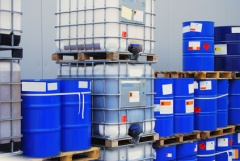Isobutanol
| Infobox on Isobutanol | |
|---|---|
| Example of Isobutanol |  |
| Facts | |
| Origin | - |
| Stowage factor (in m3/t) | - |
| Humidity / moisture | - |
| Ventilation | - |
| Risk factors | See text |
Isobutanol
Description
Isobutanol (IUPAC nomenclature: 2-methyl-1-propanol) is an organic compound with the formula (CH3)2CHCH2OH. This colourless, flammable liquid with a characteristic smell is mainly used as a solvent. Its isomers include n-butanol, 2-butanol, and tert-butanol, all of which are more important industrially.
Isobutanol is produced by the carbonylation of propylene. Two methods are practiced industrially, hydroformylation is more common and generates a mixture of normal and isobutyraldehydes, which are hydrogenated to the alcohols and then separated. Reppe carbonylation is also practiced.
Isobutanol is also produced naturally during the fermentation of carbohydrates and may also be a byproduct of the decay process of organic matter. Isobutanol, along with other low molecular weight alcohols can also be produced by some engineered microorganisms such as E. coli.
Application
Isobutanol has a variety of technical and industrial applications:
- Feedstock in the manufacture of isobutyl acetate, which is used in the production of lacquer and similar coatings, and in the food industry as a flavoring agent
- Precursor of derivative esters - isobutyl esters such as diisobutyl phthalate (DIBP) are used as plasticizers in plastics, rubbers, and other dispersions
- Paint solvent
- Varnish remover
- Ink ingredient
- Paint additive, to reduce viscosity, improve brush flow, and retard formation of oil residues (blush) on painted surfaces
- Gasoline additive, to reduce carburetor icing
- Automotive polish additive
- Automotive paint cleaner additive
- Chemical extractant in production of organic compounds
- Mobile phase in thin layer chromatography.
Isobutanol could possibly serve as an alternative to gasoline to fuel combustion engines.
Shipment / Storage / Risk factors
The product is colourless, odourless (or may have mercaptan odour), partially soluble in water, soluble in alcohol and ether.
Flammable, moderate fire risk. Strong irritant.
Freezing Point : -108°C
Flash Point: 37,7°C
Boiling Point : 107°C
Auto-Ignition Temp. : 426°C
For overseas carriage aspects of Chemicals, the readers are recommended to acquire or have access to a good chemical dictionary, and a copy of the International Maritime Dangerous Goods (IMDG) Code, issued by the International Maritime Organisation. Also consult the applicable MSDS sheet.











